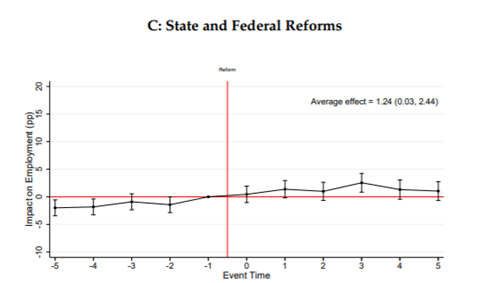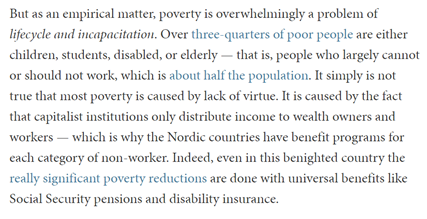One last point re:Klevan 2019.
I think that people sometimes are overselling how much it matters whether people understand the EITC.
Here’s an example from @ryanlcooper’s (excellent!) review of @mattbruenig’s paper:
https://theweek.com/articles/915088/wrong-way-fight-poverty">https://theweek.com/articles/... (1/13)
I think that people sometimes are overselling how much it matters whether people understand the EITC.
Here’s an example from @ryanlcooper’s (excellent!) review of @mattbruenig’s paper:
https://theweek.com/articles/915088/wrong-way-fight-poverty">https://theweek.com/articles/... (1/13)
It feels like folks have a bit of a dichotomy here – either people fully understand the tax code and solve the relevant Bellman equations, or they don’t react to varying incentives at all. (2/13)
But I think it’s more likely that folks are “boundedly rational” about the how the tax incentives work. They don’t necessarily understand the whole code, but they are able to min-max in their local area via guess-and-check. (3/13)
For example, EITC recipients might not know they receive something called “the EITC” but they *do* know they get a fairly substantial tax refund some years, and that they don’t receive it if they do not earn a wage income. (4/13)
To the extent that people are on the margin of participating in the labor force or not, I’d expect the payoff of the EITC to affect that decision. (5/13)
That doesn’t mean that LFPR will increase as soon as a revamped EITC is announced, but that people slowly integrate it into their decision making. One obvious mechanism is it might make people *currently* in the labor market less likely to leave. (6/13)
Which is the pattern we see in the (uncontrolled) Klevan analysis. A slow increase in the labor market participation that rises over the first three years after the EITC comes out. (7/13)
It’s also what we see in RCTs of EITC-like programs, such as the @MDRC evaluation of Paychecks Plus. https://www.mdrc.org/sites/default/files/PaycheckPlus_FinalReport_0.pdf">https://www.mdrc.org/sites/def... (8/13)
One thing that’s worth considering about when designing welfare programs or tax schemes is to what extent people can learn about them through trial and error. (9/13)
EITC has its faults but compare it to TANF, where if you have been receiving benefits for five years you lose access to it *for life*. https://twitter.com/besttrousers/status/1262474813400068101">https://twitter.com/besttrous... (10/13)
(Imagine losing access to it last month because you hadn’t properly assessed the probability of a viral pandemic when determining whether to stay on TANF in previous years) (11/13)
Of course, it’s also worth thinking about what types of programs don’t require people to learn – or even take specific actions – at all to be eligible! (12/13)
Finally, going back to @ryanlcooper’s piece it makes the important point that the population the EITC is designed for (folks who just need a few hundred dollars to push them to join the labor force) is pretty small.
There just are not that many people at that margin. (13/13)
There just are not that many people at that margin. (13/13)

 Read on Twitter
Read on Twitter





